Substitution Arg140Gly in Hemagglutinin Reduced the Virulence of Highly Pathogenic Avian Influenza Virus H7N1
Abstract
:1. Introduction
2. Materials and Methods
2.1. Reagents
2.2. Viruses
2.3. Animals
2.4. Ethics Statement
2.5. Sequencing
2.6. Infection of Chickens
2.7. Passaging the Virus through Chicken Lungs
2.8. Assessment of Intravenous Pathogenicity
2.9. Determination of the pH Value of the HA Conformational Change (Hemolysis Test)
2.10. Determination of Virus Affinity with the Receptor Analogue—Fetuin
2.11. Determination of Receptor Specificity by Competitive Inhibition
2.12. Infection of Mice
2.13. Measurement of Antibodies against Influenza Viruses in Mouse Sera
2.14. Foci Formation after Infection of MDCK Cells
2.15. Statistical Analysis
2.16. Molecular Models
3. Results
3.1. Emergence of Mutations during Passaging of the H7N1 Virus through Chicken Lungs
3.2. Arg140 Arrangement in the HA Molecule
3.3. Increasing the Pathogenicity of Virus Variants during Passage through Chicken Lungs
3.4. Intravenous Pathogenicity of Strains R5p and R6p
3.5. Pathogenicity of R5p and R6p for Mice, Compared with Highly Pathogenic Virus A/Chicken/Kurgan/5/2005 (H5N1) and Low Pathogenic Virus A/Mallard/Sweden/91/02(H7N9)
3.6. Effect of Gly140Arg Substitution on the pH-Dependent Conformational Change of HA
3.7. Effect of Charge Mutation Gly140Arg in Hemagglutinin on the Affinity for Receptor Analogs and on Receptor Specificity
3.8. Comparison Receptor Specificity Patterns of Viruses R5p and R6p
3.9. Foci of the Infected Cells Produced by the Viruses in MDCK Monolayer
4. Discussion
5. Conclusions
Author Contributions
Funding
Institutional Review Board Statement
Informed Consent Statement
Data Availability Statement
Acknowledgments
Conflicts of Interest
References
- Webster, R.G. Influenza virus: Transmission between species and relevance to emergence of the next human pandemic. Arch. Virol. Suppl. 1997, 13, 105–113. [Google Scholar]
- Gambaryan, A.S.; Matrosovich, T.Y.; Philipp, J.; Munster, V.J.; Fouchier, R.A.; Cattoli, G.; Capua, I.; Krauss, S.L.; Webster, R.G.; Banks, J.; et al. Receptor-binding profiles of H7 subtype influenza viruses in different host species. J. Virol. 2012, 86, 4370–4379. [Google Scholar] [CrossRef] [Green Version]
- Scheibner, D.; Ulrich, R.; Fatola, O.I.; Graaf, A.; Gischke, M.; Salaheldin, A.H.; Harder, T.C.; Veits, J.; Mettenleiter, T.C.; Abdelwhab, E.M. Variable impact of the hemagglutinin polybasic cleavage site on virulence and pathogenesis of avian influenza H7N7 virus in chickens, turkeys and ducks. Sci. Rep. 2019, 9, 11556. [Google Scholar] [CrossRef]
- Davison, S.; Eckroade, R.J.; Ziegler, A.F. A Review of the 1996–1998 Nonpathogenic H7N2 Avian Influenza Outbreak in Pennsylvania. Avian Dis. 2003, 47, 823–827. [Google Scholar] [CrossRef] [PubMed]
- Selleck, P.W.; Arzey, G.; Kirkland, P.D.; Reece, R.L.; Gould, A.R.; Daniels, P.W.; Westbury, H.A. An Outbreak of Highly Pathogenic Avian Influenza in Australia in 1997 Caused by an H7N4 Virus. Avian Dis. 2003, 47, 806–811. [Google Scholar] [CrossRef] [PubMed]
- Capua, I.; Marangon, S. The avian influenza epidemic in Italy (1999–2000): A review. Avian Pathol. 2000, 29, 289–294. [Google Scholar] [CrossRef] [PubMed]
- Munster, V.J.; de Wit, E.; van Riel, D.; Beyer, W.E.; Rimmelzwaan, G.F.; Osterhaus, A.D.; Kuiken, T.; Fouchier, R.A.M. The molecular basis of the pathogenicity of the Dutch highly pathogenic human influenza A H7N7 viruses. J. Infect. Dis. 2007, 196, 258–265. [Google Scholar] [CrossRef] [Green Version]
- Gao, R.; Cao, B.; Hu, Y.; Feng, Z.; Wang, D.; Hu, W.; Chen, J.; Jie, Z.; Qiu, H.; Xu, K.; et al. Human infection with a novel avian-origin influenza A (H7N9) virus. N. Engl. J. Med. 2013, 368, 1888–1897. [Google Scholar] [CrossRef] [PubMed] [Green Version]
- Zhumatov, K.K.; Sayatov, M.K.; Kydyrmanov, A.I. Influenza A/H7 viruses, distribution, genetic variability, pathogenicity for birds and humans. Eurasian J. Appl. Biotechnol. 2013, 2, 12–16. [Google Scholar] [CrossRef]
- Bisset, A.T.; Hoyne, G.F. Evolution and Adaptation of the Avian H7N9 Virus into the Human Host. Microorganisms. 2020, 8, 778. [Google Scholar] [CrossRef]
- Wu, X.; Xiao, L.; Li, L. Research progress on human infection with avian influenza H7N9. Front. Med. 2020, 14, 8–20. [Google Scholar] [CrossRef] [PubMed] [Green Version]
- Des Rochers, B.; Chen, R.E.; Gounder, A.P.; Pinto, A.K.; Bricker, T.; Linton, C.N.; Rogers, C.D.; Williams, G.D.; Webby, R.J.; Boon, A.C.M. Residues in the PB2 and PA genes contribute to the pathogenicity of avian H7N3 influenza A virus in DBA/2 mice. Virology 2016, 494, 89–99. [Google Scholar] [CrossRef]
- Dreier, C.; Resa-Infante, P.; Thiele, S.; Stanelle-Bertram, S.; Walendy-Gnirß, K.; Speiseder, T.; Preuss, A.; Müller, Z.; Stech, J.; Klenk, H.-D.; et al. Mutations in the H7 HA and PB1 genes of avian influenza a viruses increase viral pathogenicity and contact transmission in guinea pigs. Emerg. Microbes Infect. 2019, 8, 1324–1336. [Google Scholar] [CrossRef] [PubMed] [Green Version]
- Feldmann, A.; Schäfer, M.K.; Garten, W.; Klenk, H.D. Targeted Infection of Endothelial Cells by Avian Influenza Virus A/FPV/Rostock/34 (H7N1) in Chicken Embryos. J. Virol. 2000, 74, 8018–8027. [Google Scholar] [CrossRef] [Green Version]
- Wagner, R.; Gabriel, G.; Schlesner, M.; Alex, N.; Herwig, A.; Werner, O.; Klenk, H.-D. Protease Activation Mutants Elicit Protective Immunity Against Highly Pathogenic Avian Influenza Viruses of Subtype H7 in Chickens and Mice. Emerg. Microbes Infect. 2013, 2, e7. [Google Scholar] [CrossRef] [PubMed]
- Schuy, W.; Will, C.; Kuroda, K.; Scholtissek, C.; Garten, W.; Klenk, H.-D. Mutations Blocking the Transport of the Influenza Virus Hemagglutinin between the Rough Endoplasmic Reticulum and the Golgi Apparatus. EMBO J. 1986, 5, 2831–2836. [Google Scholar] [CrossRef]
- Garten, W.; Will, C.; Buckard, K.; Kuroda, K.; Ortmann, D.; Munk, K.; Scholtissek, C.; Schnittler, H.; Drenckhahn, D.; Klenk, H.-D. Structure and assembly of hemagglutinin mutants of Fowl Plague Virus with impaired surface transport. J. Virol. 1992, 66, 1495–1505. [Google Scholar] [CrossRef] [Green Version]
- McCauley, J.W.; Penn, C.R. The Critical Cut-Off Temperature of Avian Influenza Viruses. Virus Res. 1990, 17, 191–198. [Google Scholar] [CrossRef]
- Stech, J.; Stech, O.; Herwig, A.; Altmeppen, H.; Hundt, J.; Gohrbandt, S.; Kreibich, A.; Weber, S.; Klenk, H.D.; Mettenleiter, T.C. Rapid and reliable universal cloning of influenza A virus genes by target-primed plasmid amplification. Nucleic Acids Res. 2008, 36, e139. [Google Scholar] [CrossRef] [Green Version]
- Li, O.T.; Barr, I.; Leung, C.Y.; Chen, H.; Guan, Y.; Peiris, J.S.; Poon, L.L. Reliable universal RT-PCR assays for studying influenza polymerase subunit gene sequences from all 16 haemagglutinin subtypes. J. Virol. Methods 2007, 142, 218–222. [Google Scholar] [CrossRef]
- Avian Influenza (Including Infection with High Pathogenicity Avian Influenza Viruses) (Version Adopted in May 2021). OIE. Manual of Diagnostic Tests and Vaccines for Terrestrial Animals 2021. Part 3. Chapter 3.3.4. Available online: https://www.oie.int/fileadmin/Home/eng/Health_standards/tahm/3.03.04_AI.pdf (accessed on 30 June 2021).
- Matrosovich, M.; Tuzikov, A.; Bovin, N.; Gambaryan, A.; Klimov, A.; Castrucci, M.R.; Donatelli, I.; Kawaoka, Y. Early alterations of the receptor-binding properties of H1, H2, and H3 avian influenza virus hemagglutinins after their introduction into mammals. J. Virol. 2000, 74, 8502–8512. [Google Scholar] [CrossRef] [PubMed] [Green Version]
- Gambaryan, A.S.; Tuzikov, A.B.; Pazynina, G.V.; Desheva, J.A.; Bovin, N.V.; Matrosovich, M.N.; Klimov, A.I. 6-sulfo sialyl Lewis X is the common receptor determinant recognized by H5, H6, H7 and H9 influenza viruses of terrestrial poultry. Virol. J. 2008, 5, 85. [Google Scholar] [CrossRef] [Green Version]
- Russel, R.J.; Gamblin, S.J.; Haire, L.F.; Stevens, D.I.; Xiao, B.; Ha, Y.; Skehel, J.J. H1 and H7 influenza haemagglutinin structures extend a structural classification of haemagglutinin subtipes. Virology 2004, 325, 287. [Google Scholar] [CrossRef] [PubMed] [Green Version]
- Fukuyama, S.; Kawaoka, Y. The pathogenesis of influenza virus infections, the contributions of virus and host factors. Curr. Opin. Immunol. 2011, 23, 481–486. [Google Scholar] [CrossRef] [PubMed] [Green Version]
- Lomakina, N.F.; Boravleva, E.Y.; Kropotkina, E.A.; Yamnikova, S.S.; Drygin, V.V.; Gambaryan, A.S. Attenuation of A/chicken/Kurgan/3/2005 (H5N1) Influenza Virus Using Selection in an Environment Simulating the Life Cycle of Wild Duck Viruses. Mol. Genet. Microbiol. Virol. 2011, 26, 132–139. [Google Scholar] [CrossRef]
- Hensen, L.; Matrosovich, T.; Roth, K.; Klenk, H.D.; Matrosovich, M. HA-Dependent Tropism of H5N1 and H7N9 Influenza Viruses to Human Endothelial Cells Is Determined by Reduced Stability of the HA, Which Allows the Virus To Cope with Inefficient Endosomal Acidification and Constitutively Expressed IFITM3. J. Virol. 2019, 94, e01223-19. [Google Scholar] [CrossRef] [PubMed]
- Hayase, T.; Rice, K.G.; Dziegielewska, K.M.; Kuhlenschmidt, M.; Reilly, T.; Lee, Y.C. Comparison of N-glycosides of fetuins from different species and human alpha 2-HS-glycoprotein. Biochemistry 1992, 31, 4915–4921. [Google Scholar] [CrossRef] [PubMed]
- Matrosovich, M.N.; Gambaryan, A.S. Solid-phase assays of receptor-binding specificity. Methods Mol. Biol. 2012, 865, 71–94. [Google Scholar] [CrossRef]
- Okuno, Y.; Tanaka, K.; Baba, K.; Maeda, A.; Kunita, N.; Ueda, S. Rapid focus reduction neutralization test of influenza A and B viruses in microtiter system. J. Clin. Microbiol. 1990, 28, 1308–1313. [Google Scholar] [CrossRef] [Green Version]
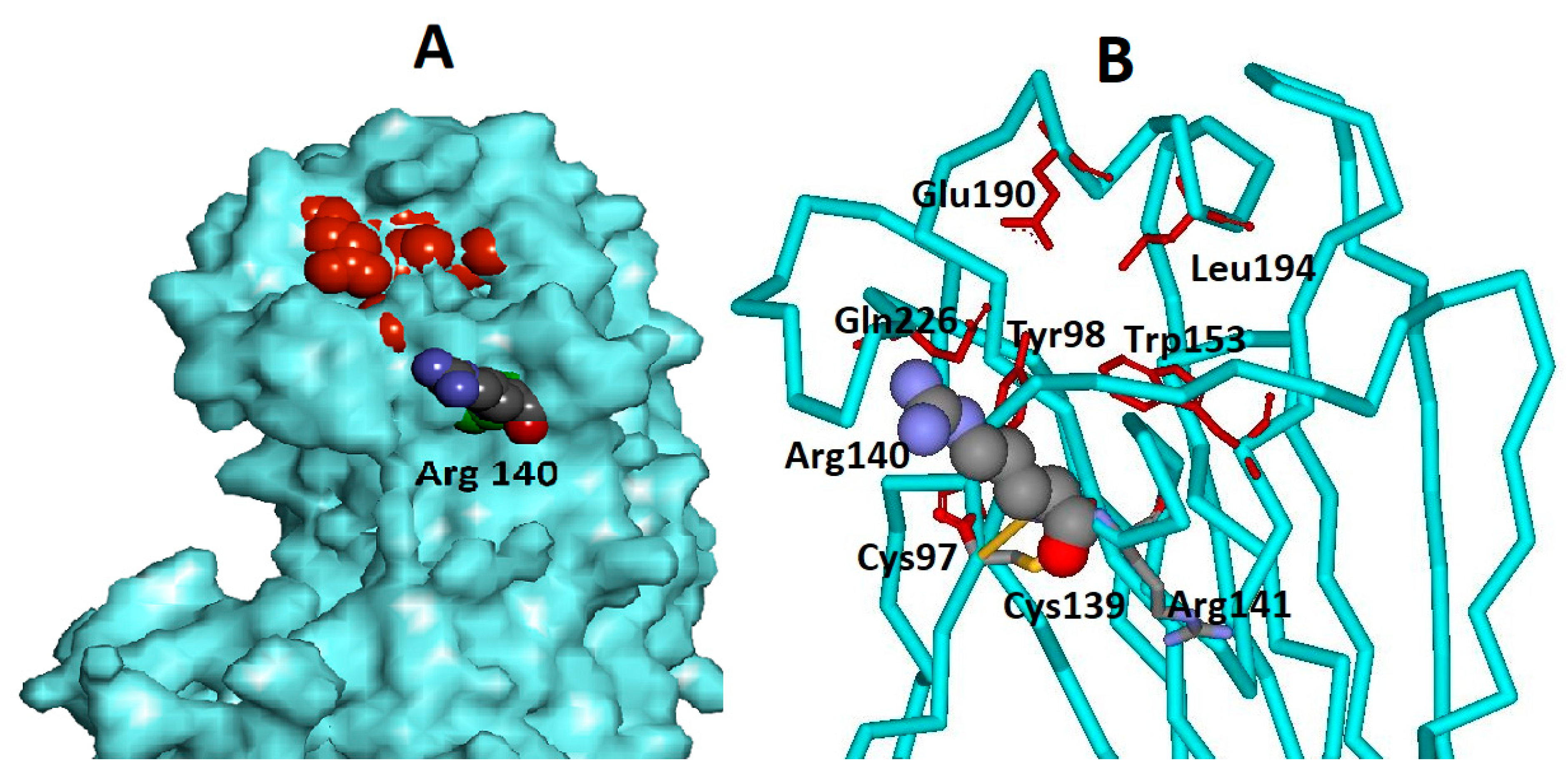
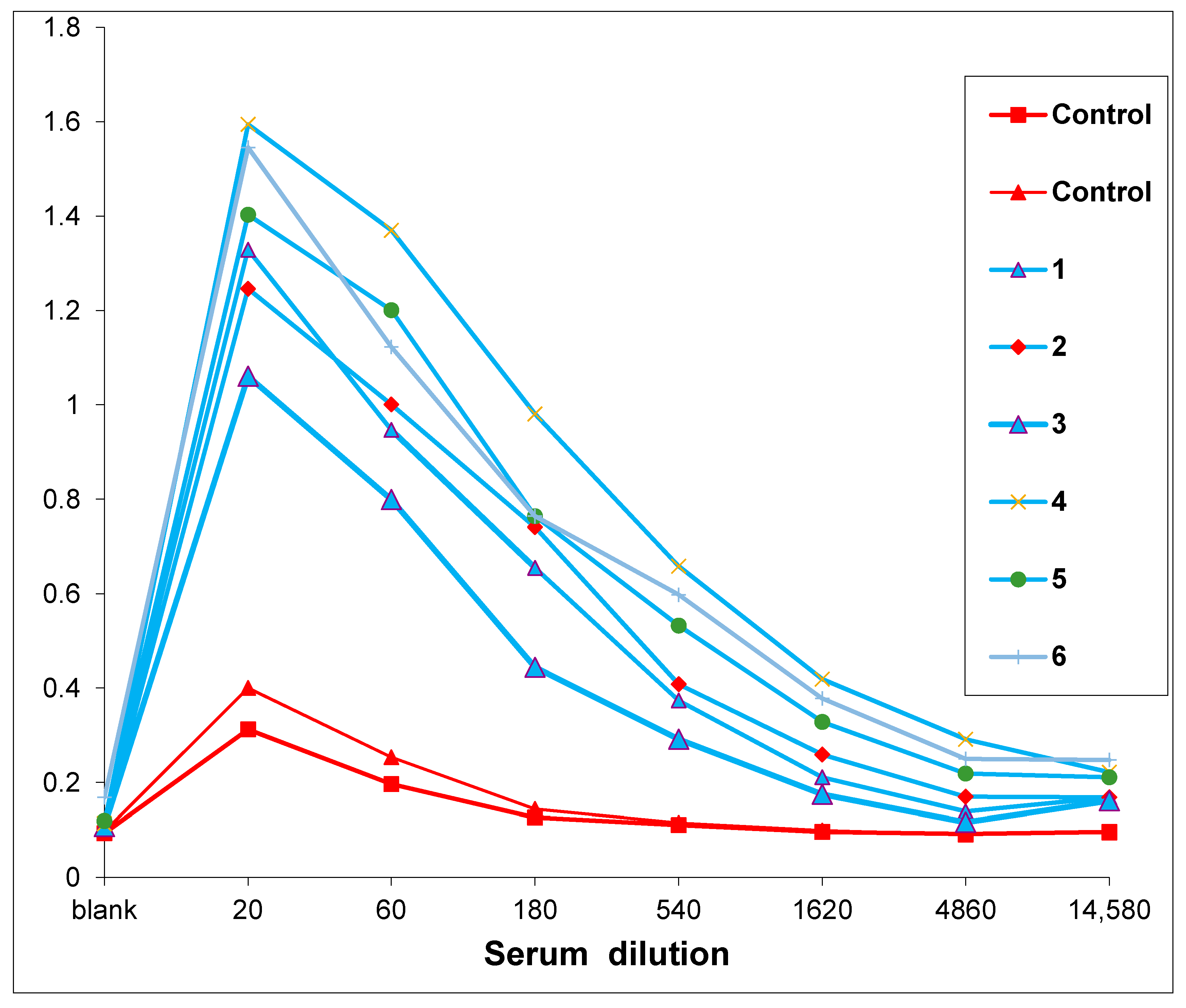
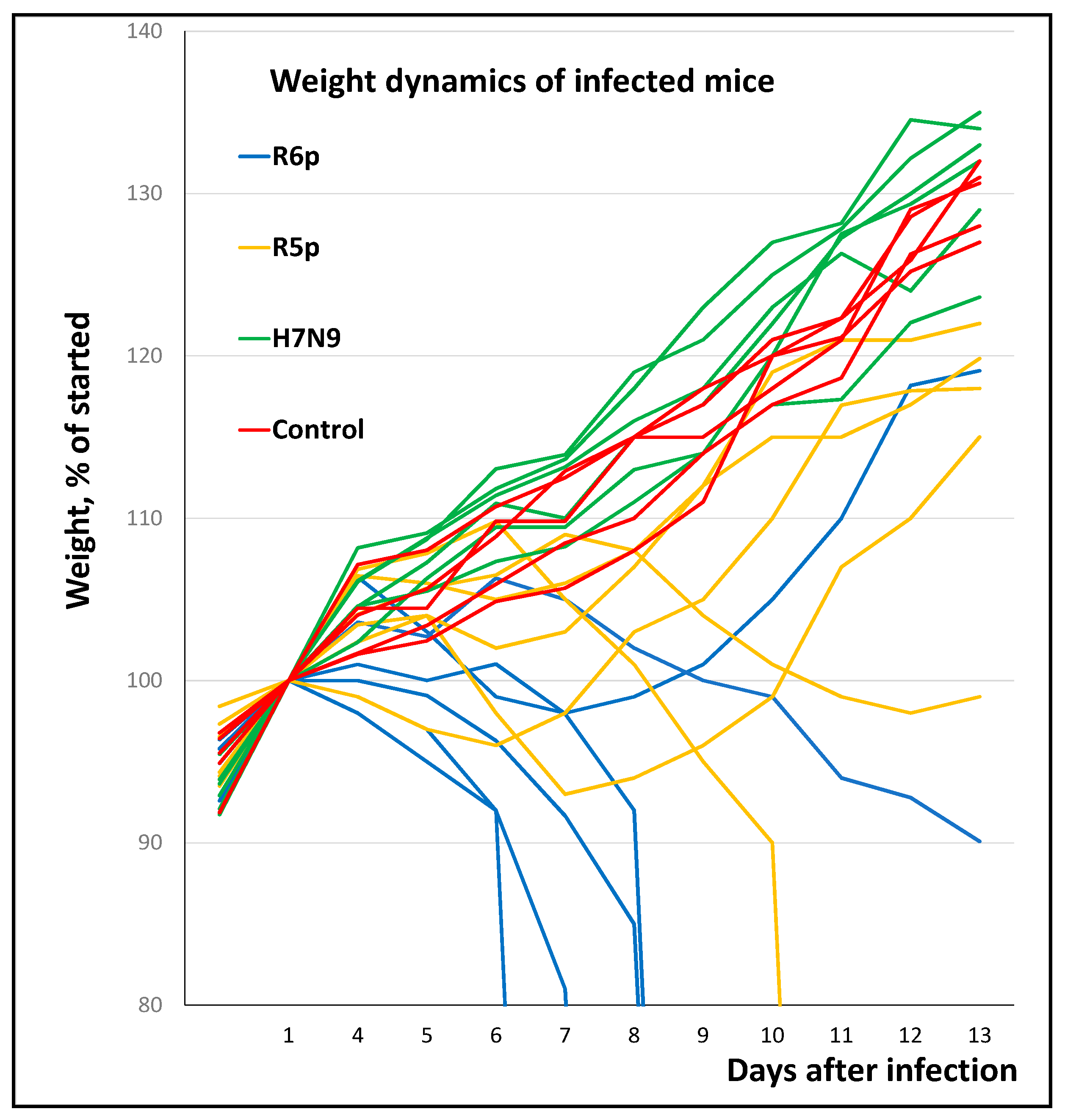
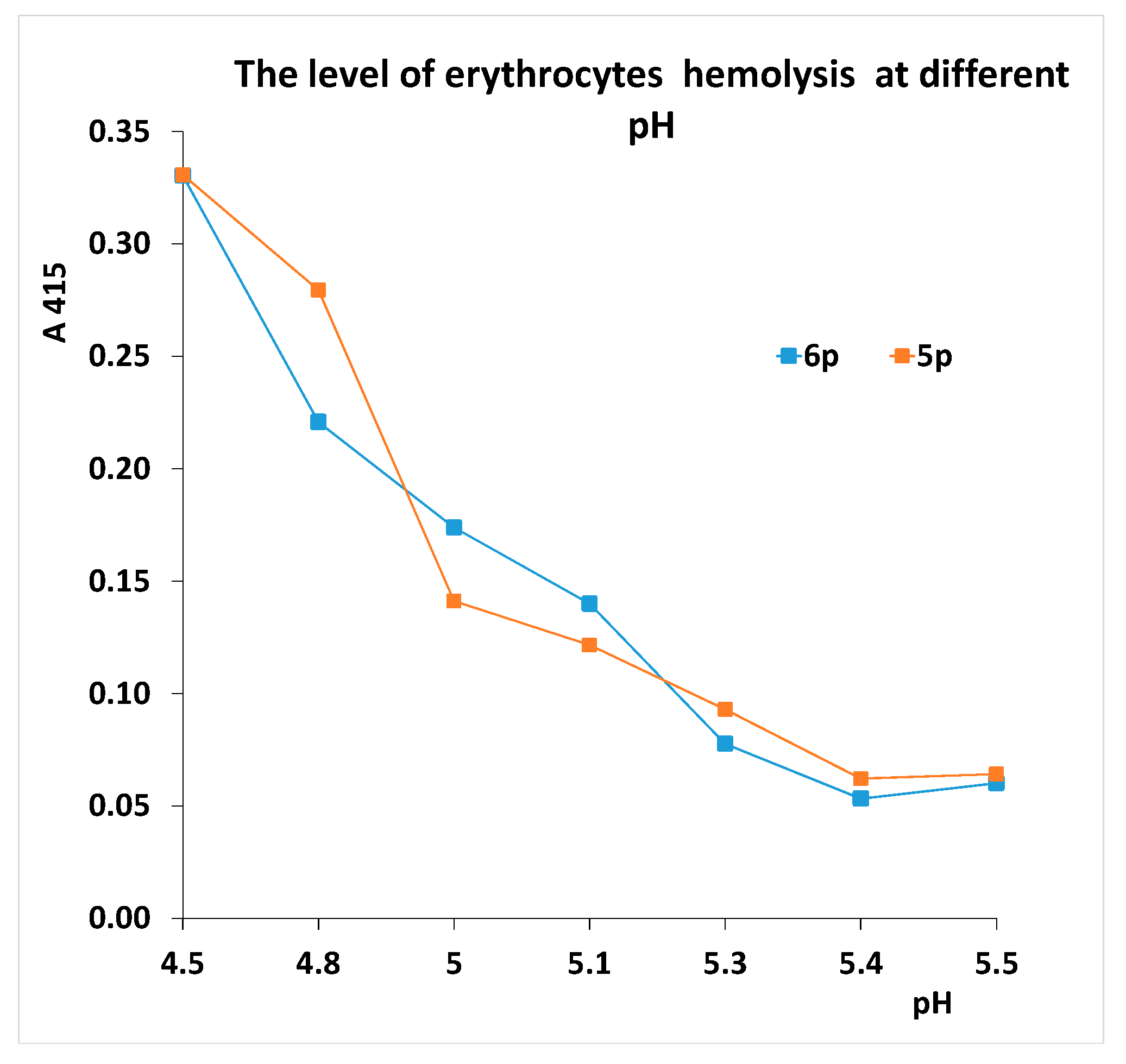
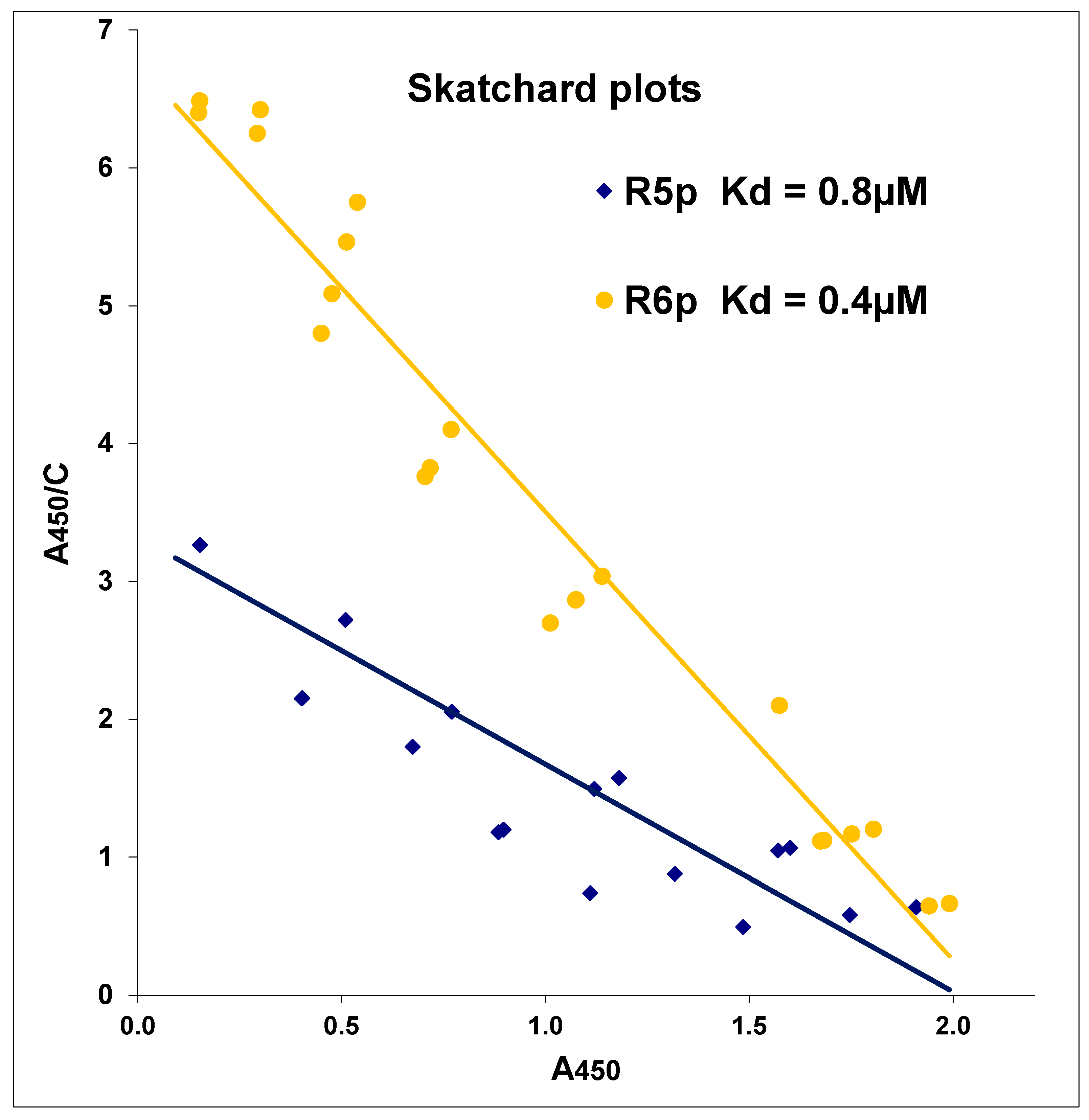
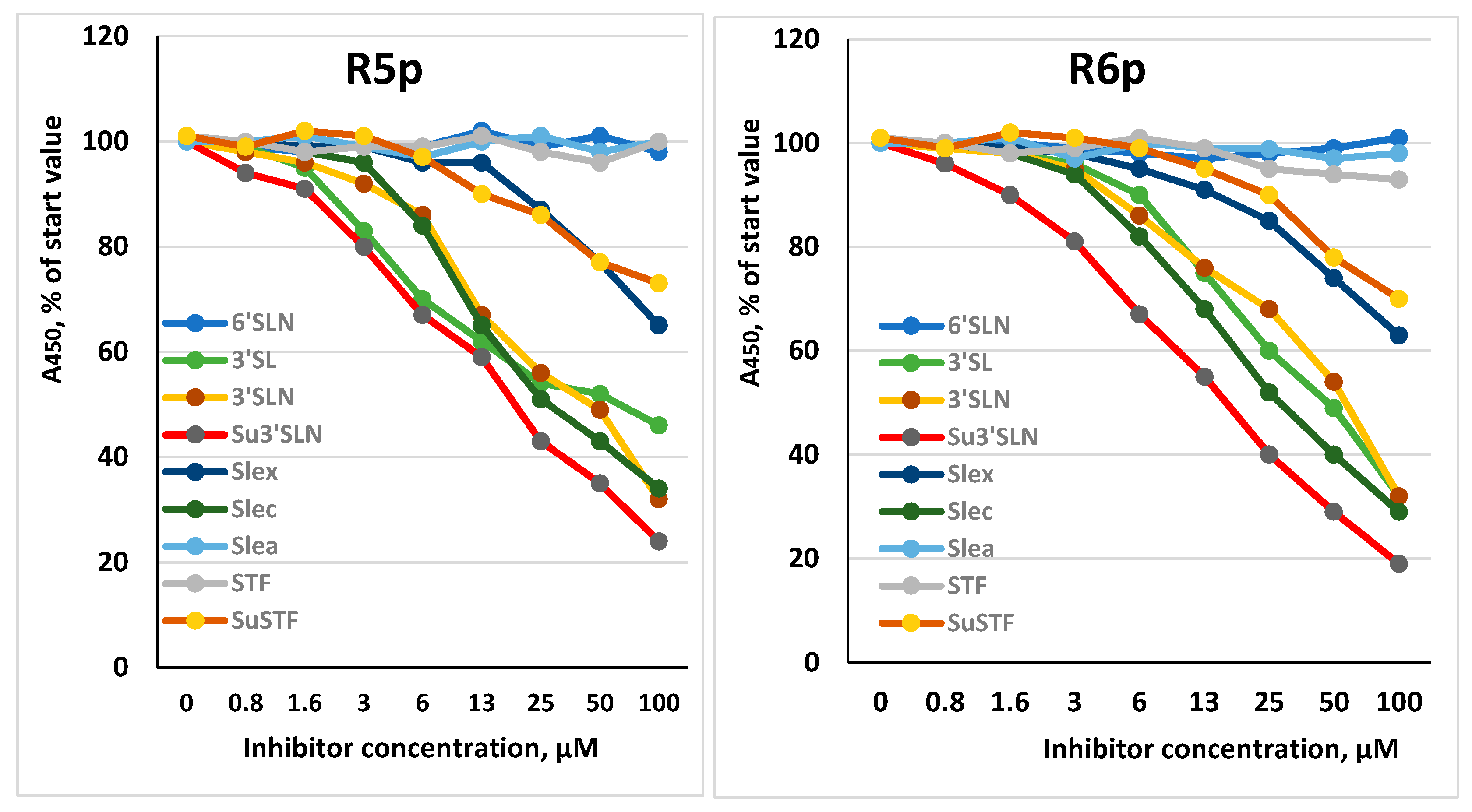
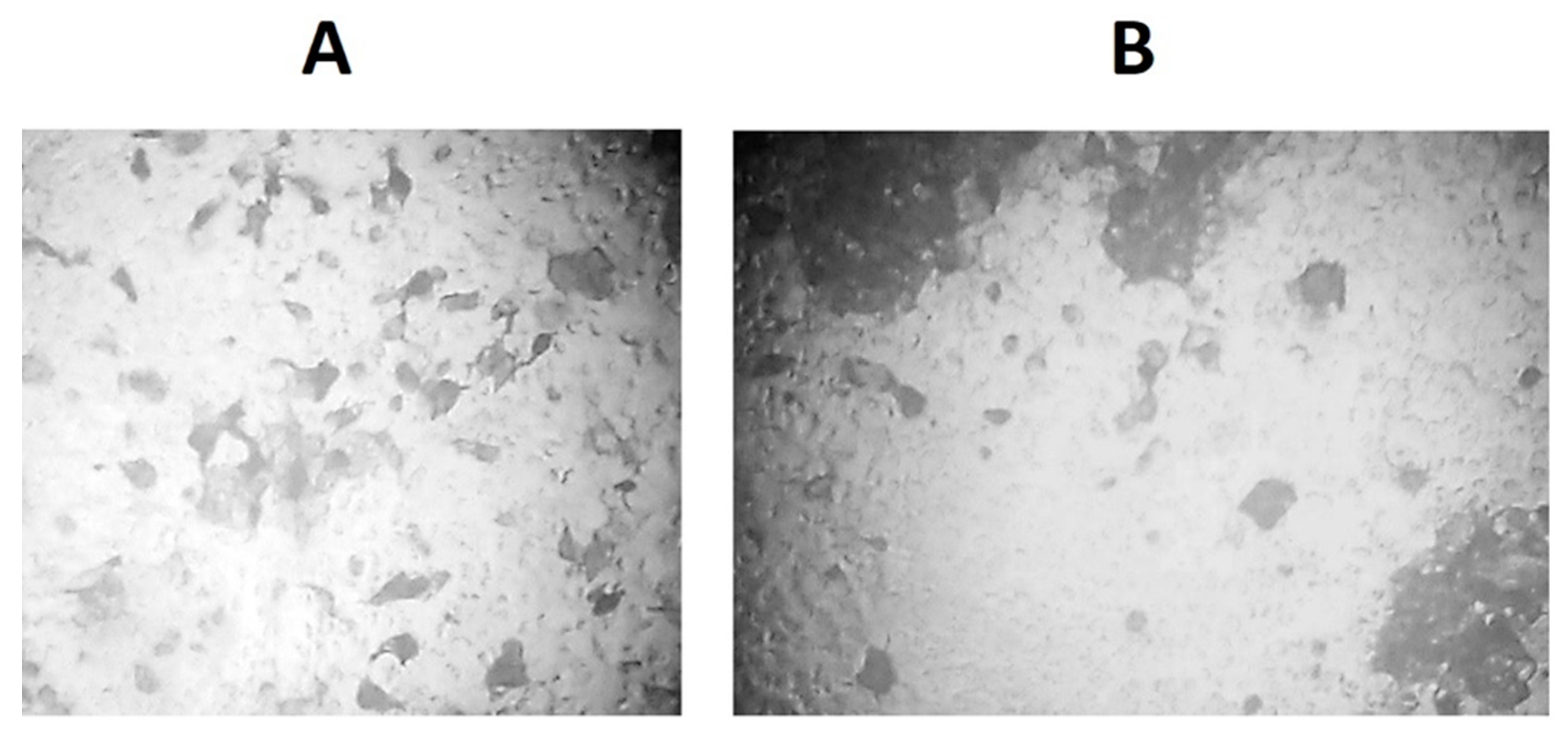
| Protein | PB2 | PB2 | PB1 | PB1-F2 | PA | HA1 | HA2 | M2 | NS1 | NS1 |
|---|---|---|---|---|---|---|---|---|---|---|
| Position * | 109 | 567 | 621 | 4 | 32 | 140 | 101 | 82 | 112 | 118 |
| 0 passages | Val | Val | Gln | Glu | Trp | Gly | Ala | Ser | Arg | Met |
| 5 passages | Phe | Ala | Lys | Glu | Ala | Gly | Thr | Ser | Arg | Arg |
| 6 passages | Phe | Ala | Lys | Glu | Ala | Arg | Thr | Ser | Arg | Arg |
| 10 passages | Phe | Ala | Lys | Gly | Ala | Arg | Thr | Arg | Lys | Arg |
| Chick Age | One-Week-Old Chicks | Eight-Week-Old Chicks | |||
|---|---|---|---|---|---|
| Variants | Designation | Infected | Survived | Infected | Survived |
| m/Sw/91/02 * | H7N9 | 6 | 6 | 2 | 2 |
| ch/Ku/5/05 * | H5N1 | 5 | 0 | 5 | 0 |
| 0 passages | R0p | 4 | 3 | 5 | 5 |
| 1 * passage | R1p | 3 | 1 | 2 | 2 |
| 2 passages | R2p | 3 | 2 | 2 | 2 |
| 3 passages | R3p | 3 | 3 | 6 | 6 |
| 4 passages | R4p | 2 | 2 | 2 | 2 |
| 5 passages | R5p | 2 | 2 | 2 | 2 |
| 6 passages | R6p | 5 | 0 | 15 | 0 |
| 7 passages | R7p | 2 | 0 | ||
| 8 passages | R8p | 2 | 0 | ||
| 9 passages | R9p | 2 | 0 | ||
| 10 passages | R10p | 2 | 0 | 6 | 0 |
| Virus | Cleavage Site of HA | a.a. in 140 HA1 | Immunogenic Dose (ImD50) | Disease Dose (DD50) | Lethal Dose (LD50) |
|---|---|---|---|---|---|
| R5p | SKKRKKR|GLF | Gly | ≤1 | 4 | 5 |
| R6p | SKKRKKR|GLF | Arg | ≤1 | 3 | 4 |
| m/Sw/91/02 | PKGR---|GLF | Arg | ≤4 | >6 | >6 |
| ch/Ku/5/05 | ERRRKKR|GLF | Pro | ≤0.3 | 0.3 | 0.3 |
| Sialyloligosaccharide | Designation |
|---|---|
| Neu5Acα2-6Galβ1-4GlcNAcβ- | 6’SLN |
| Neu5Acα2-3Galβ1-4Glcβ- | 3’SL |
| Neu5Acα2-3Galβ1-4GlcNAcβ- | 3’SLN |
| Neu5Acα2-3Galβ1-4-(6-O-Su)GlcNAcβ- | Su3’SLN |
| Neu5Acα2-3Galβ1-4(Fucα1-3)GlcNAcβ- | SLex |
| Neu5Acα2-3Galβ1-3GlcNAcβ- | SLec |
| Neu5Acα2-3Galβ1-3(Fucα1-4)GlcNAcβ- | SLea |
| Neu5Acα2-3Galβ1-3GalNAcα- | STF |
| Neu5Acα2-3Galβ1-3-(6-Su)GalNAcα- | SuSTF |
Publisher’s Note: MDPI stays neutral with regard to jurisdictional claims in published maps and institutional affiliations. |
© 2021 by the authors. Licensee MDPI, Basel, Switzerland. This article is an open access article distributed under the terms and conditions of the Creative Commons Attribution (CC BY) license (https://creativecommons.org/licenses/by/4.0/).
Share and Cite
Treshchalina, A.; Postnikova, Y.; Boravleva, E.; Gambaryan, A.; Belyakova, A.; Ishmukhametov, A.; Sadykova, G.; Prilipov, A.; Lomakina, N. Substitution Arg140Gly in Hemagglutinin Reduced the Virulence of Highly Pathogenic Avian Influenza Virus H7N1. Viruses 2021, 13, 1584. https://doi.org/10.3390/v13081584
Treshchalina A, Postnikova Y, Boravleva E, Gambaryan A, Belyakova A, Ishmukhametov A, Sadykova G, Prilipov A, Lomakina N. Substitution Arg140Gly in Hemagglutinin Reduced the Virulence of Highly Pathogenic Avian Influenza Virus H7N1. Viruses. 2021; 13(8):1584. https://doi.org/10.3390/v13081584
Chicago/Turabian StyleTreshchalina, Anastasia, Yulia Postnikova, Elizaveta Boravleva, Alexandra Gambaryan, Alla Belyakova, Aydar Ishmukhametov, Galina Sadykova, Alexey Prilipov, and Natalia Lomakina. 2021. "Substitution Arg140Gly in Hemagglutinin Reduced the Virulence of Highly Pathogenic Avian Influenza Virus H7N1" Viruses 13, no. 8: 1584. https://doi.org/10.3390/v13081584
APA StyleTreshchalina, A., Postnikova, Y., Boravleva, E., Gambaryan, A., Belyakova, A., Ishmukhametov, A., Sadykova, G., Prilipov, A., & Lomakina, N. (2021). Substitution Arg140Gly in Hemagglutinin Reduced the Virulence of Highly Pathogenic Avian Influenza Virus H7N1. Viruses, 13(8), 1584. https://doi.org/10.3390/v13081584







